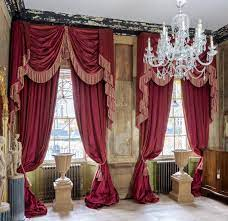In the 15th Century, the first curtains entered the homes of the wealthy. Textiles were used to warm up interiors and soften the look of stark rooms, but not draped over windows. The windows were small, narrow slits that were covered by oiled wax paper or internal shutters. In the Tudor and Stuart eras, expensive curtains made of silk, velvet, and brocades were imported to show wealth and status.
The use of hand-made curtain trimmings increased in England at the end of the 17th century. This was due to designers seeking inspiration from France and its court. The beautiful fringes and tassels, also known as “passementerie”, were used to decorate window coverings and bedding.
As curtain rods were hidden by pelmets and curtain tie-backs, pelmets also became popular. The pull-up curtain, the predecessor of modern blinds, was also designed to fit the new style multi-paned sash windows. Deep, rich colours were the most popular. Popular colours were blacks and reds, accentuated with metallic threads. For Curtains Cheltenham, visit https://laskeys.com/bespoke-curtains/curtains-cheltenham/
In the 18th century walls and windows were treated as a part of a decorative scheme. Lighter fabrics were also hung on walls. Thomas Chippendale, the famous cabinet maker, designed carved wooden gilded window pelmets that became popular and often covered at least one third of the windows. The use of silver, gold, and puff-balls made of silk, as well as ostrich feathers in colours as outrageous as candy pink and acid green, enriched the passementerie.
In the late 1700s, a huge variety of fabrics was now available, including silks and damasks as well as velvets, voiles and taffetas. The palette was more vibrant than ever – turquoise, daffodil yellow and raspberry were all popular.
Victorians were known for their love of bringing back old fashions. The 19th century was a time of many styles and trends. Charles Darwin could have had floral fringed curtains on his four-poster bed!
As the 20th Century approached, the Victorian fussiness that was often oppressive gave way to a much simpler style. Art Nouveau, popularised in the years leading up to World War I, was inspired by a variety of forms. However, the overall appearance was more elegant and simple. Beds were left bare, and windows were always dressed in paired curtains or blinds and sometimes with fabric panels with motifs. Pale colours were chosen to create an airy and light feel.
In the mid-20th century, the introduction of automatic washing machines led to a greater use of washable fabrics like linens and cottons. While the interiors in the post-war era were often very austere and plain, geometric prints and textured fabrics became very popular by the mid-1950s.



